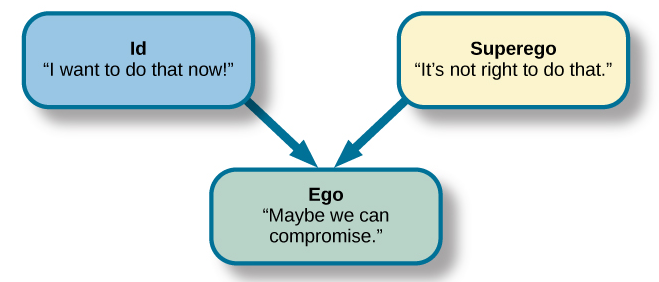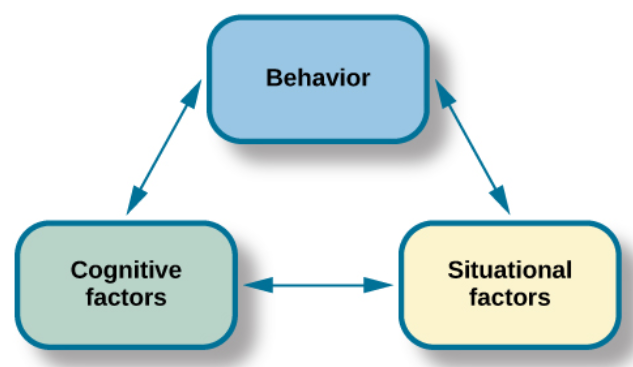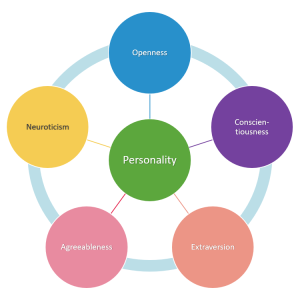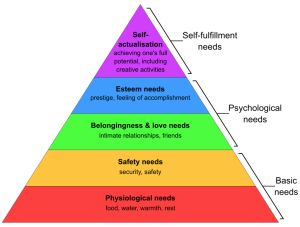4.3 Approaches to Explaining Personality
In this chapter, we will have a closer look at eight distinct (but sometimes interrelated) approaches to personality. In the following sections, you will learn about each approach in a little more detail. While reading the overviews of each approach, you may feel that you can relate better to some of them than to others, depending on your professional background, previous education and personal experiences. We will deal with some of the approaches in more detail than with others, depending on their perceived relevance for conflict management. The approaches that we will consider in some more detail are the trait approach and the cognitive approach.
As you learn about the various approaches, you are encouraged to reflect on how each approach may be useful to help understand and support people in conflict (we will consider this question in more detail in the next topic (4.4), but you might have some original ideas yourself). You are encouraged to record your reflections at the end of this topic. We will start with an overview of the so-called “grand theories” of personality, which are included in the six approaches discussed by Burger (2019). Beyond those six approaches, we will also consider two more contemporary theories of personality: the narrative approach and positive psychology.
Psychoanalytic Approach
Within the psychoanalytic approach, there is an emphasis on the “unconscious” – it is proposed that a person’s personality is shaped by hidden forces over which we have no control. This approach holds that we are motivated by our unconscious needs, wishes and fears. These unconscious factors, in turn, create internal conflict as they encounter social constraints causing us anxiety. These powerful forces exist within us and can be traced back to our primitive drives or instincts.
There are two schools of thought within the psychoanalytic approach – the Freudian theories (which focus more on these primitive drives and instincts) and the Neo-Freudian theories (which focus more on people’s childhood experiences). We will briefly consider and distinguish both schools of thought here.
Reading
One key pillar of Freud’s theories is the assumption that a person’s “ego” is concerned with finding a balance between the aggressive and pleasure-seeking drives of the “id” and the moral control of the “superego”.

Reading
Biological Approach
The biological approach draws upon theories and research suggesting inherited predispositions and physiological processes that can explain individual differences in personality. As you read through the biological approach, you may wish to go back to Chapter 1 (1.5) to refresh your memory about “Genetics”.
Reading
You may also wish to broaden your understanding of the nature versus nature debate.
Behavioural/Social Learning Approach
In its extreme form, behaviourism limits personality to the study of observable behaviours. The behaviourism approach was the dominant school of thought during the 1930s and humans were seen as a “blank slate” and that all behaviours are learnt from the environment you live in. Social learning grew out of this purist approach and argued that personality is a product of a dynamic interaction between the environment and the person. That is, not only does the environment influence our behaviour, but also that behaviour then determines the kind of environment we find ourselves in, which can then influence behaviour, and so on.
This approach was majorly influenced by the work of Albert Bandura, who developed the so-called social-cognitive theory. As part of this theory, Bandura developed the “Reciprocal Determinism Model” (see diagram below) that illustrates the interrelationship between a person’s behaviour, internal/ cognitive factors (such as thoughts, beliefs, values, expectations) and external/ situational factors (e.g., rewards and punishment).

Besides reciprocal determinism, one of Bandura’s most important contributions to understanding human behaviour and personality was the concept of observational learning. This concept proposes that we learn by observing, reading, or hearing about other people’s actions. We will consider this concept in the next topic when we apply knowledge from personality psychology to conflict management.
Reading
Trait Approach
The trait approach views personality as a unique combination of traits that shape a person’s thoughts, feelings, and behaviours (McAdams, 2009). People are rated along continuums that describe the degree to which an individual displays a specific trait (Burger, 2019).
Reading
To rate people on a trait continuum, trait researchers typically use self-report tests. As we look into some of the major traits that are being discussed as part of this approach to personality, you may wish to find out a little bit more about how you would fare on some of the tests that focus on personality traits.
Different trait theorists have developed different theories and measurements that they believe are most useful to describe people’s overall personality (not looking at single traits but those traits that in combination make a person). Since we will consider the trait approach in some more detail in terms of its relevance for understanding people in conflict and conflict resolution, we will look at some of these theories and measures in some more detail now.
Cattell’s 16PF Questionnaire
One well-known and popular assessment is the personality trait scale developed by Raymond Cattell (1905-1998) to which you were introduced in the above reading. This trait scale, referred to as the 16PF, measures the 16 dimensions that Cattell proposed to be “core traits” of a person. Cattell assumed that each person contains all of these 16 traits to a certain degree. The 16 traits operate on a continuum with the scale determining where on the continuum the person falls. These traits include:
- Abstractedness: Imaginative versus practical
- Apprehension: Worried versus confident
- Dominance: Forceful versus submissive
- Emotional stability: Calm versus highly-strung
- Liveliness: Spontaneous versus restrained
- Openness to change: Flexible versus attached to the familiar
- Perfectionism: Controlled versus undisciplined
- Privateness: Discreet versus open
- Reasoning: Abstract versus concrete
- Rule-consciousness: Conforming versus non-conforming
- Self-reliance: Self-sufficient versus dependent
- Sensitivity: Tender-hearted versus tough-minded
- Social boldness: Uninhibited versus shy
- Tension: Inpatient versus relaxed
- Vigilance: Suspicious versus trusting
- Warmth: Outgoing versus reserved
You can view the 16PF here.
The Big 5 or Five Factor Model (FFM)

As you learned in the overview reading for this section, the most popular theory in personality psychology today is the Five Factor Model, which focuses on five key personality traits and is therefore also referred to as the Big 5 personality traits. These traits include:
- Openness
- Conscientiousness
- Extroversion
- Agreeableness
- Neuroticism
The Big 5 traits are measured with the NEO Personality Inventory test or revised versions of it (Carlson et al., 2019; Costa & McCrae, 1985; 1992). You can view a version of the NEO PI test.
The Dark Triad Traits
Some trait theorists have identified some dispositions that are thought to reflect the darker sides of the personality. The term “dark triad” is used to refer to a combination of these traits, including narcissism, Machiavellianism and psychopathy. Similar to the Big 5, these traits operate on a continuum whereby we are all thought to possess, to a certain degree, elements of these traits. The Dark Triad traits are commonly assessed with the Dirty Dozen Scale (Jonason & Webster, 2010). In 2011, Delroy Paulhus and Daniel Jones published the Short Dark Triad (SD3) as a single short test to measure all three traits at once. You can view the SD3 online.
Humanistic Approach
Humanistic psychology stems from European existential philosophy focusing on the meaning of human existence, the role of free will, and the uniqueness of each human being. According to humanistic theorists, humans are driven by an all-encompassing motivational force to actualise and fulfil one’s full potential and sense of self. Humanistic theory provides an optimistic approach to understanding personality.
Reading
Human Needs Theories
One well-known humanistic theorist is Abraham Maslow who developed the hierarchy of needs theory. This theory proposes human beings share certain needs and that these needs must be met in a particular order. The highest need is the need for “self-actualization”, a term that refers to the achievement of a person’s fullest potential.
Maslow and his theory informed Burton’s (1990) basic human needs theory, which is a theory frequently referred to in conflict management studies since this theory has been an important theory to help explain conflict.

Cognitive Approach
The cognitive approach focuses on the individual ways in which people process information, including how they notice factors in their environment and react to them (Burger, 2019). Thereby, the cognitive approach considers individual people in their social environments (McAdams, 2009).
Please read Chapter 15 in Personality (Burger, 2019). Already the first page of the chapter provides a practical example of the cognitive approach, which should give you a bit of an idea of what the cognitive approach focuses on.
You may also want to go back to Chapter 2, (the cognitive mind), to refresh your memory about the various cognitions that we discussed and that relate to how people notice and process information.
Personal Construct Theory
One theory used as part of this approach appears to have great relevance to conflict management, which is why we will briefly introduce it here. Kelly (1991; 2001) proposed that people use a unique set of personal constructs to interpret and predict their environment. An individual’s construct system influences which characteristics of others a person notices when processing information about relevant events.
Kelly (1991; 2001) proposed that people’s construct systems are dynamic and that people, based on ongoing experiences with their environment, continuously revise existing constructs, or form new constructs. However, some constructs are core or impermeable constructs and these are difficult to change (Kelly, 1991; 2001). We will consider this theory in some more detail as part of topics 4 and 5 when we look at how the various approaches may find application for explaining and managing/resolving conflict.
People’s personal constructs can be investigated by using Kelly’s (1991; 2001) Role Construct Repertory Test (Rep Test). This test is a common and accepted research tool to measure cognitive complexity and has been used to explore individual differences in phenomena like friendships (McAdams, 2009; Menasco & Curry, 1978). You can view more details about the rep test below:
The Narrative Approach
While the narrative approach to conceptualising personality does not form part of the earlier mentioned “grand theories” and is frequently not introduced as a distinct approach in personality psychology literature, we will consider it here as a more contemporary approach to personality. The narrative approach is of interest for conflict management because narratives are an important element when it comes to people’s conflict experiences. Depending on how they are crafted, conflict narratives can either hinder or foster effective management of a conflict. Considering how narratives relate to personality can thus provide some interesting insights into the topic of conflict narratives.
Reading
According to the narrative approach, individual differences in personality can be observed in the life stories people construct as they integrate the past, present, and future to provide their lives with a sense of unity, purpose, and meaning. According to the narrative approach, personality is expressed in the psychosocial patterns of a person’s life story. The psychosocial patterns include the interaction of psychological factors (e.g., thoughts, feelings, moods, beliefs, values, traits) with social structures that are shaped by factors like ethnicity, sexual orientation, social roles and norms, etc.
We are complex human beings. The focus of the narrative approach is to provide a framework for our identities and to bring together the disparate aspects of the self to form a unified and coherent story. It is through our life stories that our narrative identities emerge and within this identity, we can find meaning, purpose, and direction in our lives.
To learn more about the narrative approach and how it views the “self as a story”, you may wish to watch the following presentation by Dan Mc Adams [48:58], the “father of the narrative approach to personality”:
To deepen your understanding of the narrative approach, you may also wish to read the following short reading:
Reading
McAdams, D. P. (2006). The role of narrative in personality psychology today. Narrative Inquiry, 16(1), 11-18.
Positive Psychology
Positive psychology focuses on human potential and is sometimes viewed as a sub-branch of the humanistic approach. The founders of positive psychology, however, have distanced themselves from humanistic theorists, and we will consider positive psychology as a distinct contemporary approach to personality in this chapter.
The last 20 years of the positive psychology movement has seen a ‘revolution of thought’ in social science and the measurement of positive psychological assessment. Positive psychology is defined as a scientific approach and practical pursuit of understanding optimal human functioning (Lopez & Snyder, 2009). Positive psychological assessment is also referred to in the literature as psychometric measures. The field of positive psychology encompasses a range of subjective research including wellbeing, contentment, satisfaction, optimism, flow, happiness, and hope (Snyder, 2002). According to Seligman & Csikszentmihalyi (2000), through studying positive traits, individuals will learn to “…build the qualities that help individuals and communities, not just to endure and survive, but also to flourish.” (p. 5).
So how does positive psychology explain differences in personality? Positive psychology assumes that positive psychological characteristics are linked to certain personality traits. As part of the trait approach, you were introduced to various approaches that conceptualise personality dimensions (traits), including the “Big 5”. For example, Bhullar et al., (2020) refer to research that “has found that individuals with more outgoing and positive personalities generally experience and report greater positive psychological characteristics compared with individuals endorsing more negative personality dimensions.” (p. 423). Such positive psychological characteristics include, for example, well-being, gratitude, self-compassion, grit, mindfulness, character strengths and social influence.
Bhullar et al., (2020) explain that the connections between a person’s positive functioning and personality traits lie in “the Big Five trait pattern of high extraversion, high agreeableness, high conscientiousness, high openness, and low neuroticism” (p. 426). This constellation of the Big 5 and positive psychology characteristics, the authors conclude, may form the basis for a person’s adaptive and growth functioning.
To learn more about the specific links between the Big 5 and positive psychology characteristics, you may wish to read:
Reading
Bhullar, N., Schutte, N.S. and Wall, H.J. (2020). Personality and positive psychology. In B. J. Carducci, C.S. Nave, J.S. Mio & R.E. Riggio (Eds), The Wiley encyclopedia of personality and individual differences. https://doi.org/10.1002/9781119547181.ch335
If you are interested in learning more now about positive psychology and its take on personality watch this Ted talk by Seligman himself [23:43]:
You may also wish to read the following related article in The Conversation.
Reflection Activity

